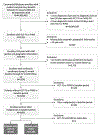Burden of Illness Associated with Tenosynovial Giant Cell Tumors
- PMID: 29580718
- PMCID: PMC7440779
- DOI: 10.1016/j.clinthera.2018.03.001
Burden of Illness Associated with Tenosynovial Giant Cell Tumors
Abstract
Purpose: Little is known about the burden of illness in patients with tenosynovial giant cell tumors (TGCT), which are rare, typically benign, lesions of the synovial tissue including giant cell tumor of the tendon sheath (GCT-TS) and pigmented villonodular synovitis (PVNS). The objective of this study was to describe health care resource use and costs for patients with GCT-TS and PVNS, which are rare and typically benign TGCT.
Methods: A retrospective cohort study design was used to analyze administrative claims for adult commercial and Medicare Advantage health plan enrollees with evidence of GCT-TS and PVNS from January 1, 2006 through March 31, 2015. Participants were continuously enrolled for 12 months before (pre-index period) and 12 months after (post-index period) the date of the first tenosynovial giant cell tumor (TGCT) claim (index date). Preindex and postindex measures were compared using the McNemar test and Wilcoxon signed-rank test. Results were stratified by TGCT type.
Findings: The study identified 4664 patients with TGCT, 284 with GCT-TS, and 4380 with PVNS. Mean age (GCT-TS group: 50 years; PVNS group: 51 years) and sex distributions (GCT-TS group: 60.2% female; PVNS group: 59.5% female) were similar for each group. Most patients with GCT-TS (78.2%) had at least one postindex surgery, compared with 38.7% of patients with PVNS. Mean total health care costs increased from $8943 in the preindex period to $14,880 in the postindex period (P < 0.001) for GCT-TS and from $13,221 in the preindex period to $17,728 in the postindex period (P < 0.001) for PVNS. Preindex to postindex ambulatory costs increased nearly 120% for patients with GCT-TS ($4340 to $9570, P < 0.001) and 50% for patients with PVNS ($6782 to $10,278, P < 0.001), and physical therapy use increased significantly during the same period (GCT-TS: 18% to 40%, P < 0.001; PVNS: 38% to 60%, P < 0.001).
Implications: Costs increased substantially 1 year after the first TGCT claim, with more than half the costs covering ambulatory care. These results suggest a high health care burden once TGCT is identified.
Keywords: giant cell tumor of the tendon sheath; healthcare costs; pigmented villonodular synovitis; retrospective claims study; tenosynovial giant cell tumors.
Copyright © 2018 Elsevier HS Journals, Inc. All rights reserved.
Figures




References
-
- Blay JY, El Sayadi H, THiesse P, Garret J, Ray-Coquard I. Complete response to imatinib in relapsing pigmented villonodular synovitisi/tenosynovial giant cell tumor. Ann Oncol. 2008;19:821–822. - PubMed
Publication types
MeSH terms
Grants and funding
LinkOut - more resources
Full Text Sources
Other Literature Sources

